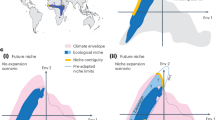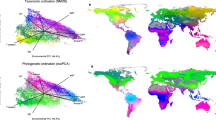Abstract
How large numbers of species coexist on a seemingly limited number of different resources is a classic problem in ecology1, and attempts have been made to solve it experimentally. But we are not convinced that Huisman and Weissing's2 proposal to add non-stationary dynamics in species abundance to the list of possible explanations offers any new insight into this biodiversity enigma.
Similar content being viewed by others
Main
Early ideas were based on competitive exclusion, in which two (or more) species compete for shared resources but only the more proficient survives3, and the number of coexisting species, n, does not exceed the number of available resources, k. But these ideas based on competitive exclusion cannot explain how rich ensembles of species can coexist on a limited number of resources (that is, n>k), as in aquatic ecosystems.
A solution to this biodiversity problem has been suggested by Huisman and Weissing2 in the form of a model demonstrating the possibility of coexistence of two or more competitors under conditions of fluctuating (periodic or chaotic) community dynamics, a finding central to contemporary ecological theory4. However, we believe that their solution to the n>k puzzle has long been known5,6,7,8,9,10,11,12,13.
It was first inferred from a computer simulation over 25 years ago5 that two species can coexist on one biotic resource, with coexistence occurring along what appeared to be a periodic orbit, as was also shown by Huisman and Weissing2. This was confirmed analytically and expanded to cover the more general case of n species coexisting on one biotic resource9. The fact that coexistence depends on the nonlinearity of the species-specific growth functions and on the lack of system equilibrium — the central issue discussed by Huisman and Weissing2 — has also been demonstrated earlier8. The plankton paradox (whereby n>k) was thus resolved about two decades after it was first posed as a biodiversity problem.
References
Hutchinson, G. E. Am. Nat. 95, 137–145 ( 1961).
Huisman, J. & Weissing, F. J. Nature 402, 407–410 (1999).
Gause, G. J. The Struggle for Existence (Williams & Wilkins, Baltimore, 1934).
Sommer, U. Nature 402, 366–367 ( 1999).
Koch, A. L. J. Theor. Biol. 44, 387–395 (1974).
Armstrong, R. A. & McGehee, R. J. Theor. Biol. 56, 499–502 ( 1976).
Armstrong, R. A. & McGehee, R. Theor. Popul. Biol. 9, 317–328 ( 1976).
Armstrong, R. A. & McGehee, R. Am. Nat. 115, 151–170 (1980).
McGehee, R. & Armstrong, R. A. J. Diff. Equns 23, 30–52 (1977).
Kalan, J. L. & Yorke, J. A. Am. Nat. 111, 1032–1036 (1977).
Ebenhöh, W. Ecol. Modell. 75/76, 83–98 (1994).
Yodzis, P. Introducton to Theoretical Ecology (Harper & Row, New York, 1989).
Fryxell, J. M. & Lundberg, P. Individual Behavior and Community Dynamics (Chapman & Hall, London, 1997).
Author information
Authors and Affiliations
Corresponding author
Rights and permissions
About this article
Cite this article
Lundberg, P., Ranta, E., Kaitala, V. et al. Coexistence and resource competition. Nature 407, 694 (2000). https://doi.org/10.1038/35037672
Issue Date:
DOI: https://doi.org/10.1038/35037672
This article is cited by
Comments
By submitting a comment you agree to abide by our Terms and Community Guidelines. If you find something abusive or that does not comply with our terms or guidelines please flag it as inappropriate.



